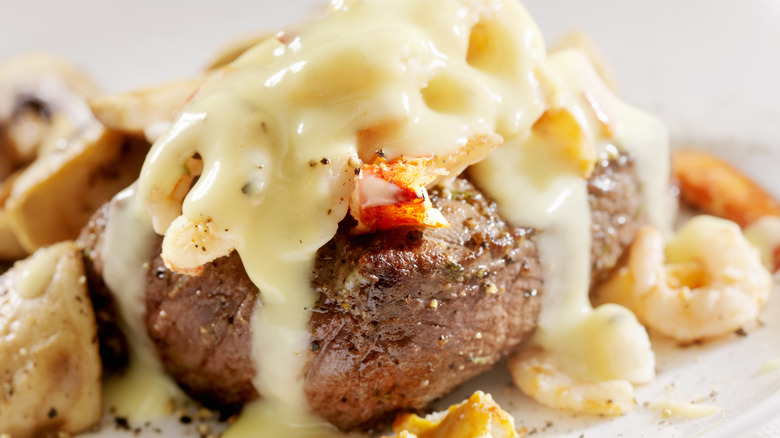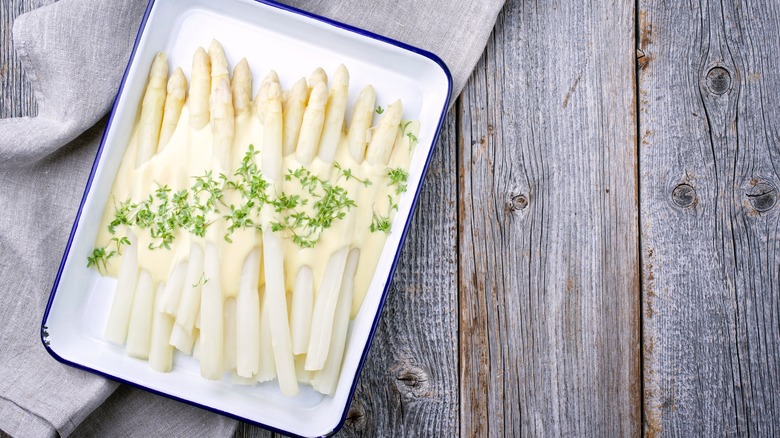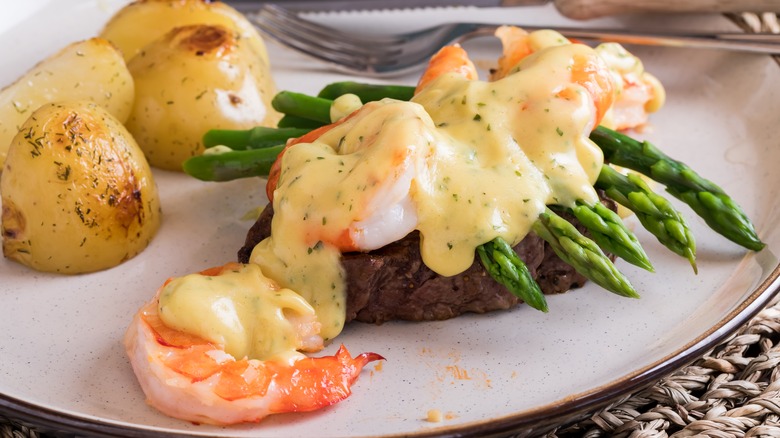The Most Luxurious Part Of Oscar-Style Steak Is ... The Asparagus?
It's hard to imagine a richer, more decadent steak dish than Oscar-style steak, named for 19th-century Swedish king Oscar II. The king enjoyed veal piled high with crab meat and butter sauce and served asparagus. Over time, as the recipe spread from King Oscar II's table to upscale restaurants, filet mignon replaced veal, lobster became interchangeable with crab, and the simple butter sauce turned into buttery French favorites like béarnaise or hollandaise. The asparagus, however, remains the same, and it wasn't any old green asparagus that adorned the king's plate.
Oscar-style steak was originally served with two spears of white asparagus, a vegetable so unusual that it may be been the most prized ingredient in a dish teeming with luxuries. How many types of produce can you name that grow without any sun exposure? White asparagus is grown using this complicated method, which sets it apart from the more common green variety. This special asparagus also costs a lot more due to its rarity and meticulous growing process, and boasts a softer texture and more nuanced sweet and nutty flavors. These are the kind of exclusive and delicate qualities that would appeal to royalty.
The rarity of white asparagus
Shielding asparagus from the sun by covering it with soil prevents photosynthesis, and keeps it from acquiring a chlorophyll-induced green color. It was most likely the Romans who first discovered this effect over 2,000 years ago, or at least, they were the first to write about it. Several European nations, however, have a long history of growing labor-intensive white asparagus, including France, Germany, and Italy.
No matter where it's grown, white asparagus is very difficult to cultivate and harvest. It takes three to four years for white asparagus to mature, and to pry each stalk from its sun-shaded soil, farmers have to use specially-made knives. The colorless vegetable is typically only in season from April to June, and it's rarely found in standard U.S. grocery stories.
Because of its rarity, white asparagus has a long history with nobility. In Germany, for example, it's often referred to as the "king of vegetables," and in the Italian city of Bassano del Grappa, it was originally reserved only for nobles. Is it any wonder, then, that a Swedish king would want it on his plate alongside his veal, crab meat, and butter sauce?
A steak dish fit for a king or queen
King Oscar II reportedly enjoyed his special dish for the first time in 1897, and many years later, it proved popular with those of non-royal lineage, too — notably at New York City's legendary steakhouse Delmonico's. As previously mentioned, the king's beloved veal cutlets have largely given way to prime cuts of filet mignon or beef tenderloin, and changing out crab meat for lobster makes the dish even more decadent. Some recipes even use shrimp. However, one substitution that really changes the vibe of the dish is switching the white asparagus for the common green variety.
The disappearance of white asparagus from many modern Oscar-style recipes is due to the difficulty of finding it, but it's ironic that a dish celebrated for its luxury is often made without its rarest ingredient. If you ever manage to buy a few spears of expensive white asparagus, try preparing this dish the way royalty would have enjoyed it.



